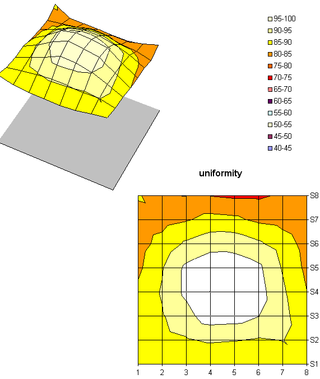BenQ's FP71e+ LCD Is Fast, But How Furious?
And Beyond
We measured the uniformity of lighting on the panel. To do this, we set the panel at 50% brightness, 50% contrast and measure the uniformity of the lighting on a uniform white image, divided into 64 areas of equal size. The brightest point is considered 100%, the black value previously measured is considered 0% and then the other values measured are distributed in between.

Several observations are in order. First of all, the lighting is very uniform. The values range over only 20% of the scale, which is quite a bit better than the results for our Prophetview 920 Pro.
Further, the distribution of values is at least symmetrical compared to the vertical. In this respect it's much better than the XP17 for example. There is, however, a gradient in the image. The lower part of the image is brighter than the upper part; but the difference is not dramatic: 5% at most. That's far from the light gradients we've noted on monitors like the IIYAMA AS4314UT.
In the final analysis, the panel is very uniform and has good contrast. And aside from the color rendering, which is slightly below par, I have to say it's reassuring to see that BenQ hasn't sacrificed everything to reduce latency. That's a point in favor of the FP71E+.
Stay on the Cutting Edge
Join the experts who read Tom's Hardware for the inside track on enthusiast PC tech news — and have for over 25 years. We'll send breaking news and in-depth reviews of CPUs, GPUs, AI, maker hardware and more straight to your inbox.
Most Popular

